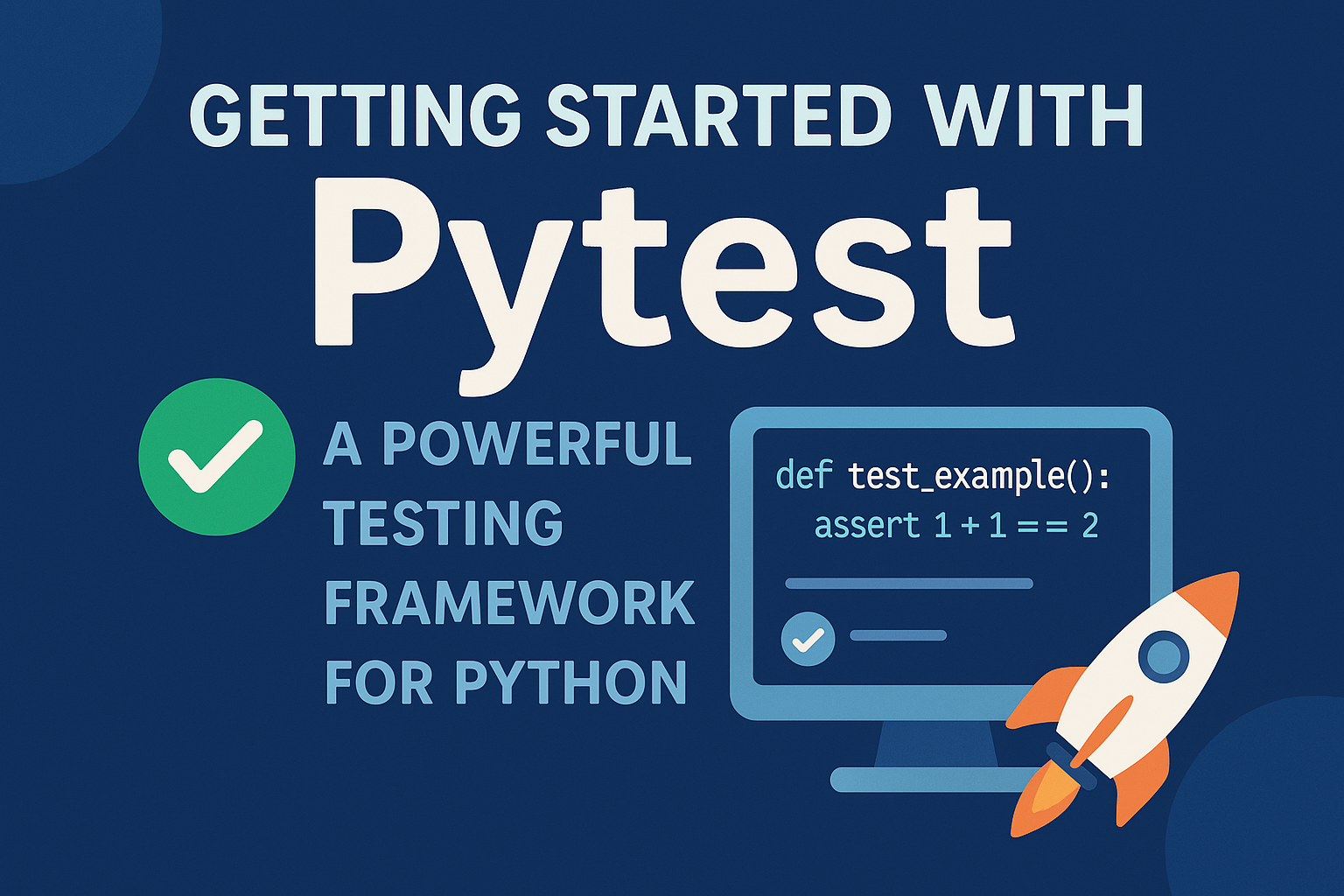Getting Started with PyTest: A Powerful Testing Framework for Python
Testing is an essential part of software development, ensuring code quality and maintainability. PyTest is a flexible and easy-to-use testing framework that simplifies writing, running, and maintaining tests in Python.
In this article, we’ll explore PyTest, its features, and different use cases to help you master efficient testing. ✅
🎯 Why PyTest?
PyTest offers powerful features that make testing easier:
- ✅ Simple and readable syntax – No need for boilerplate code.
- 🔍 Automatic test discovery – Finds and runs tests automatically.
- 🛠 Built-in assertion introspection – Detailed failure messages.
- 🔄 Fixtures for setup and teardown – Reusable test dependencies.
- 📊 Parameterized testing – Run tests with multiple input values.
- 🔌 Rich ecosystem of plugins – Extend functionality as needed.
🔧 Installing PyTest
To install PyTest, run:
1
pip install pytest
Verify the installation:
1
pytest --version
Now you’re ready to start testing! 🚀
📝 Writing Your First Test
A basic PyTest test is just a function with assertions:
1
2
3
4
5
6
# test_math.py
def add(x, y):
return x + y
def test_add():
assert add(3, 5) == 8
Run the test using:
1
pytest
PyTest will automatically discover the test file and execute the function. ✅
📌 Assertions in PyTest
PyTest uses Python’s built-in assert statement, making tests easy to read.
1
2
3
def test_strings():
assert "pytest" in "pytest framework"
assert len("hello") == 5
If a test fails, PyTest provides detailed output for debugging. 🧐
🔄 Parameterized Tests
Avoid repetitive tests by using @pytest.mark.parametrize:
1
2
3
4
5
6
7
8
9
import pytest
@pytest.mark.parametrize("x, y, expected", [
(1, 2, 3),
(2, 3, 5),
(10, 5, 15),
])
def test_add(x, y, expected):
assert add(x, y) == expected
This executes the test multiple times with different values. 🚀
🔧 Using Fixtures for Setup and Teardown
Fixtures provide reusable setup and teardown logic:
1
2
3
4
5
6
7
8
9
import pytest
@pytest.fixture
def sample_data():
return {"name": "Alice", "age": 30}
def test_data(sample_data):
assert sample_data["name"] == "Alice"
assert sample_data["age"] == 30
Fixtures make tests clean and maintainable. ✅
📁 Organizing Tests with Classes
You can group related tests into classes:
1
2
3
4
5
6
class TestMathOperations:
def test_add(self):
assert add(4, 6) == 10
def test_subtract(self):
assert (10 - 5) == 5
Test classes should be prefixed with Test, and test methods should start with test_. 📌
🛠 Mocking External Dependencies
To test code that interacts with external systems, use pytest-mock:
1
pip install pytest-mock
Example:
1
2
3
4
5
6
def fetch_data():
return {"status": "success", "data": [1, 2, 3]}
def test_fetch_data(mocker):
mocker.patch("__main__.fetch_data", return_value={"status": "error"})
assert fetch_data()["status"] == "error"
Mocking prevents tests from relying on real external services. 🚀
🎯 Running Specific Tests
Run all tests:
1
pytest
Run a specific test file:
1
pytest test_math.py
Run a single test function:
1
pytest test_math.py::test_add
Enable verbose output for more details:
1
pytest -v
Run tests in a specific directory:
1
pytest tests/
📊 Measuring Code Coverage
To check how much of your code is covered by tests, install pytest-cov:
1
pip install pytest-cov
Run tests with coverage measurement:
1
pytest --cov=my_project
This helps identify untested parts of the codebase. ✅
⚠️ Handling Expected Failures
Mark a test as expected to fail due to known issues:
1
2
3
4
5
import pytest
@pytest.mark.xfail(reason="Bug in function")
def test_failing():
assert 1 == 2
This prevents known issues from breaking your test suite. 🛠
📌 Using PyTest Plugins
Extend PyTest with plugins:
pytest-cov– Measures test coverage.pytest-mock– Simplifies mocking.pytest-django– Django-specific testing tools.pytest-xdist– Runs tests in parallel.
Install a plugin:
1
pip install pytest-xdist
Run tests in parallel:
1
pytest -n 4 # Uses 4 CPU cores
Speed up test execution! 🚀
📌 Understanding Test Execution Flow with Mermaid
Visualizing test execution flow helps understand how PyTest works internally:
graph TD;
Start --> |Test Discovery| PyTest;
PyTest --> |Collect Tests| TestCases;
TestCases --> |Run Tests| Assertions;
Assertions --> |Pass or Fail| Results;
Results --> End;
PyTest automatically discovers, runs, and reports test results efficiently. ✅
🏆 Best Practices for Writing PyTest Tests
✔ Keep tests short and focused – One assertion per test is ideal.
✔ Use fixtures to manage test setup/teardown.
✔ Write parameterized tests to avoid redundancy.
✔ Run tests frequently to catch issues early.
✔ Measure test coverage and improve untested areas.
🎯 Conclusion
PyTest is a powerful and flexible testing framework that simplifies writing and running tests. 🚀 With features like fixtures, parameterized tests, and plugins, it’s an essential tool for Python developers.
Start using PyTest today and build reliable software! ✅
